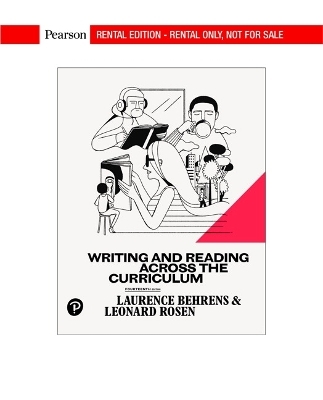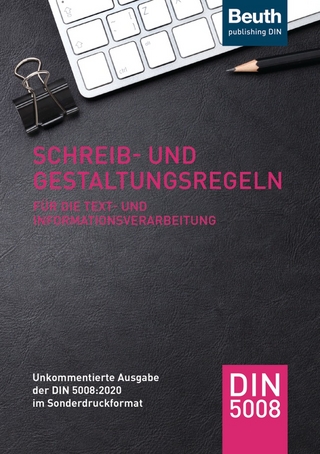
Writing and Reading Across the Curriculum
Pearson (Verlag)
978-0-13-466851-2 (ISBN)
- Titel ist leider vergriffen;
keine Neuauflage - Artikel merken
For courses in writing across the curriculum.
Writing skills for any major
A best-¿selling interdisciplinary composition text for over 35 years, Writing and Reading Across the Curriculum guides readers through essential college-¿level writing skills such as summary, critique, synthesis, analysis, and research. It provides step-by-step instruction in writing papers based on source materials and includes exercises bridging the gap between reading and writing. An anthology provides cross¿-disciplinary readings on topics that overlap with content from the humanities, sciences, and social sciences. A major revision, the 14th edition provides new topics, readings, and content on writing and argumentation that address the issues and interests of readers today.
About our authors Laurence Behrens has focused for more than 35 years on interdisciplinary approaches to the teaching of undergraduate writing. His Writing and Reading Across the Curriculum, coauthored with Leonard J. Rosen, originally published in 1982 and now in its 14th Edition, was the first widely used cross-curricular textbook in freshman composition. Dr. Behrens earned an AB in Theatre Arts from Brandeis University, an MFA in Film, Radio and Television from Columbia University, and a PhD in literature from UCLA. He has taught at UCLA, the University of California at Irvine, The American University in Washington, D.C., and most recently, at the University of California, Santa Barbara. He was one of the original members of the interdisciplinary Writing Program at UCSB, where he originated the lower division course in writing about classical music. He has also taught lower-division courses in writing about sociology and psychology. At the upper division level, he has taught business writing, legal writing and writing about history and film studies, as well as graduate seminars in writing for teaching assistants. His articles have appeared in College English, College Composition and Communication, The English Journal, The Maryland Composition Review, Freshman English News, The Journal of Aesthetics and Art Criticism, Notes and Queries, Literature/Film Quarterly and The Journal of the University Film Association. In addition to Sequence for Academic Writing and Writing Across the Curriculum, Dr. Behrens' other books with Leonard J. Rosen include Writing Papers in College, Reading for College Writers, Theme and Variations: The Impact of Great Ideas, and The Allyn & Bacon Handbook. He has also authored the historically oriented The American Experience: A Writer's Sourcebook and the legal casebook for undergraduate writers, Making the Case: An Argument Reader. Leonard Rosen earned a BA in English and Education at Trinity College (Hartford). He then taught high school English in Baltimore City before earning his PhD in Literary Studies, with a focus on composition, at The American University. He went on to teach at Bentley University and in the Expository Writing Program at Harvard University. In addition to best-selling textbooks coauthored with Laurence Behrens, most notably Writing and Reading Across the Curriculum and Sequence for Academic Writing, he has written (and read) commentaries for Boston's NPR station and written numerous op-eds published in The Boston Globe, Chronicle of Higher Education and elsewhere. He is also an award-winning novelist, the author of All Cry Chaos (translated into 10 languages) and The Tenth Witness.
An Introduction to Thinking and Writing in College
Defining Academic Thinking and Writing
Cultivating Intellectual Curiosity
Exploring Similarities and Differences
Arguing with Logic and Evidence
Challenging Arguments
Communicating Critical Thinking Through Writing
PART I: STRUCTURES AND STRATEGIES
Summary, Paraphrase, and Quotation
Previewing to Understand the Author’s Purpose
Exercise 1.1 Previewing a Paragraph
External Enhancements of Memory May Soon Go High-Tech–Jyutika Mehta
Forming a Preliminary Understanding of Topic and Purpose
Rereading for Content and Structure
How Brains Remember
Exercise 1.2 Marking Up a Passage
Critical Reading for Summary
Summarizing and Paraphrasing Parts of Sources
When to Summarize and Paraphrase
Summarizing Parts of Sources
Can a Summary Be Objective?
Paraphrasing Parts of Sources
Summarizing Entire Works
Guidelines for Writing Summaries
Read, Reread, and Highlight
Divide into Stages of Thought and Write a Brief Summary of Each Stage of Thought
Write a Thesis: A Brief Summary of the Entire Passage
Write Your Summary
Write a One- or Two-Sentence Summary
Write a Middle-Length Summary
Write an Expanded Summary
Where Do We Find Written Summaries?
Summarizing Challenging Sources
Reading and Summarizing Challenging Sources
Demonstration Summary of Paul Bloom’s “The Baby in the Well”
The Baby in the Well: The Case Against Empathy–Paul Bloom
Write a Brief Summary of Each Stage of Thought
Write a Thesis: A Brief Summary of the Entire Passage
Write a Draft by Combining Thesis, Section Summaries, and Selected Details
Summarizing Graphs, Charts, and Tables
Bar Graphs
Exercise 1.3 Summarizing Graphs
Line Graphs
Exercise 1.4 Summarizing Line Graphs
Pie Charts
Exercise 1.5 Summarizing Pie Charts
Other Charts: Bubble Maps, Pictograms, and Interactive Charts
Tables
Exercise 1.6 Summarizing Tables
Choosing Quotations
When to Quote
Quote Memorable Language
Quote Clear, Concise Language
Quote Authoritative Language
Altering Quotations
Use Ellipses to Indicate Omissions
Use Brackets to add or Substitute Words
Avoiding Classic Mistakes in Quoting
Avoid Quoting Too Much
Quote Only What You Need
Avoid Freestanding Quotations
Understand When to Use First and Last Names
Don’t Introduce Well-Known Names
Exercise 1.7 Incorporating Quotations
Using Signal Phrases
Signal Verbs to Introduce Quotations, Summaries, and Paraphrases
Signal Verbs and Tense
Six Strategies for Using Signal Phrases (or Sentences)
Identifying Phrase at the Beginning
Identifying Phrase in the Middle
Identifying Phrase at the End
Reference to a Source Preceded by That
Identifying Sentence at the Beginning–With a Colon
Block Quotation
Incorporating Quotations into Your Sentences
Exercise 1.8 Summarizing, Paraphrasing, and Quoting a Brief Passage
How to Use Sources to Build Paragraphs
Avoiding Plagiarism
Rules for Avoiding Plagiarism
Critical Reading and Critique
Critical Reading
Question 1: To What Extent Does the Author Succeed in His or Her Purpose?
Writing to Inform
Evaluating Informative Writing
Accuracy of Information
Web Sites and the Trust Factor: Know What Sort of Site You’re On
Significance of Information
Fair Interpretation of Information
Writing to Persuade
Exercise 2.1 Informative and Persuasive Thesis Statements
Evaluating Persuasive Writing
Consumer Watchdog
Americans Shouldn’t Demand a “Right to Be Forgotten: Online—Washington Post
The Right to Bury the (Online) Past—Liza Tucker
Exercise 2.2 Critical Reading Practice
Persuasive Strategies
Clearly Defined Terms
Fair Use of Information
Logical Argumentation: Avoiding Logical Fallacies
Emotionally Loaded Terms
Ad Hominem Argument
Faulty Cause and Effect
Either/or Reasoning
Tone
Hasty Generalization
False Analogy
Begging the Question
Non Sequitur
Oversimplification
Exercise 2.3 Understanding Logical Fallacies
Writing to Entertain
Question 2: To What Extent Do You Agree with the Author?
Identify Points of Agreement and Disagreement
Exercise 2.4 Exploring Your Viewpoints—in Three Paragraphs
Explore Reasons for Agreement and Disagreement: Evaluate Assumptions
Inferring and Implying Assumptions
Determining the Validity of Assumptions
Critique
How to Write Critiques
Guidelines for Writing Critiques
Demonstration: Critique
Model Critique: Critique of “The Right to Bury the (Online) Past” by Liza Tucker—Ethel Weiss
Exercise 2.5 Informal Critique of the Model Critique
Critical Reading for Critique
Thesis, Introduction, and Conclusion
Writing a Thesis
The Components of a Thesis
Making an Assertion
Starting with a Working Thesis
Using the Thesis to Plan a Structure
How Ambitious Should Your Thesis Be?
Exercise 3.1 Drafting Thesis Statements
Introductions
Quotation
Historical Review
Review of a Controversy
From the General to the Specific
Anecdote and Illustration: From the Specific to the General
Question
Statement of Thesis
Exercise 3.2 Drafting Introductions
Conclusions
Summary (Plus)
Statement of the Subject’s Significance
Call for Further Research
Solution/Recommendation
Anecdote
Quotation
Question
Speculation
Exercise 3.3 Drafting Conclusions
Explanatory Synthesis
What Is a Synthesis?
Using Summary and Critique as a Basis for Synthesis
Using Inference as a Basis for Synthesis: Moving Beyond Summary and Critique
Identifying Your Purpose
Example: Same Sources, Different Uses
Where Do We Find Written Syntheses?
Using Your Sources
Types of Syntheses: Explanatory and Argument
Seau Suffered from Brain Disease—Mary Pilon and Ken Belson
Concussion Problem Not Unique to U-M—The State News Editorial Board
How to Write Syntheses
Guidelines for Writing Syntheses
Writing an Explanatory Synthesis
Demonstration: Explanatory Synthesis—The “Idea” of Money
Exercise 4.1 Exploring the Topic
A Brief History of Money: Or, How We Learned to Stop Worrying and Embrace the Abstraction—James Surowiecki
Apple, Banks in Talks on Mobile Person-to- Person Payment Service—Robin Sidel and Daisuke Wakabayashi
Consider Your Purpose
Exercise 4.2 Critical Reading for Synthesis
Formulate a Thesis
Decide How You Will Use Your Source Material
Develop an Organizational Plan
Organize a Synthesis by Idea, Not by Source
Write Your Synthesis
Explanatory Synthesis: First Draft
Revise Your Synthesis
Exercise 4.3 Revising the Explanatory Synthesis
Model Explanatory Synthesis: The “Idea” of Money—Sheldon Kearney
Critical Reading for Synthesis
Argument Synthesis
What Is an Argument Synthesis?
The Elements of Argument: Claim, Support, and Assumption
Exercise 5.1 Practicing Claim, Support, and Assumption
The Three Appeals of Argument: Logos, Ethos, Pathos
Logos
Deductive Reasoning
Inductive Reasoning
Maintaining a Critical Perspective
Exercise 5.2 Using Deductive and Inductive Logic
Ethos
Exercise 5.3 Using Ethos
Pathos
Exercise 5.4 Using Pathos
The Limits of Argument
Fruitful Topics for Argument
How to Write Argument Syntheses
Demonstration: Developing an Argument Synthesis—Responding to Bullies
Bullying Statistics—Pacer.org
The 2013 National School Climate Survey: The Experiences of Lesbian, Gay, Bisexual, and Transgender
Youth in Our Nation’s Schools—Joseph G. Kosciw, Emily A. Greytak, Neal A. Palmer, and Madelyn J.
Boesen
Olweus Bullying Prevention Program
White House Report/Bullying—And the Power of Peers—Philip Rodkin
Exercise 5.5 Critical Reading for Synthesis
Consider Your Purpose
Making a Claim: Formulate a Thesis
Decide How You Will Use Your Source Material
Develop an Organizational Plan
Draft and Revise Your Synthesis
Model Argument Synthesis: Responding to Bullies—Peter Simmons
The Strategy of the Argument Synthesis
Developing and Organizing the Support for Your Arguments
Summarize, Paraphrase, and Quote Supporting Evidence
Provide Various Types of Evidence and Motivational Appeals
Use Climactic Order
Use Logical or Conventional Order
Present and Respond to Counterarguments
Use Concession
Developing and Organizing Support for Your Arguments
Avoid Common Fallacies in Developing and Using Support
The Comparison-and- Contrast Synthesis
Organizing Comparison-and- Contrast Syntheses
Organizing by Source or Subject
Organizing by Criteria
Exercise 5.6 Comparing and Contrasting
A Case for Comparison and Contrast: World War I and World War II
Comparison and Contrast Organized by Criteria
Model Exam Response
The Strategy of the Exam Response
Summary of Synthesis Chapters
Analysis
What Is an Analysis?
Where Do We Find Written Analyses?
from The Invisible Addiction: Cell-Phone Activities and Addiction among Male and Female College Students—James A. Roberts, Luc Honore Petnji Yaya, and Chris Manolis
What’s in a Phone?—Jon Agar
Selecting and Using an Analytical Tool
Selecting the Analytical Tool
Using the Analytical Tool
Exercise 6.1 Using a Principle or Definition as a Tool for Analysis
Planning and Writing the Analysis Paper
Devising a Thesis
Developing the Paragraph-by- Paragraph Logic of Your Paper
Writing the Analysis Paper
Guidelines for Writing Analyses
Reviewing Your Analysis: Does It Pass Key Tests?
Have You Written a Summary Rather than an Analysis?
Is Your Analysis Systematic?
Have You Answered the “So What?” Question?
Have You Attributed Sources?
Critical Reading for Analysis
When Your Perspective Guides the Analysis
Exercise 6.2 Planning an Analysis
Demonstration: Analysis
Model Analysis: The Case of the Missing Kidney: An Analysis of Rumor—Linda Shanker
Works Cited
Locating, Mining, and Citing Sources
Source-Based Papers
Where Do We Find Written Research?
Writing the Research Paper
Developing a Topic into a Research Question
Brainstorming a Topic
Narrowing Your Topic
The Research Question
Exercise 7.1 Constructing Research Questions
Getting Started with Research
Consult Knowledgeable People
Familiarize Yourself with Your Library’s Resources
Locating Preliminary Sources
Encyclopedias
Wikipedia: Let the Buyer Beware
Exercise 7.2 Exploring Encyclopedias
Biographical Sources
Statistical Sources
Overviews and Bibliographies
Conducting Focused Research
Types of Sources
Books
Book Reviews
Newspapers, Magazines, and Journals
Newspapers
Magazines
Journals (Scholarly Material)
Exercise 7.3 Exploring Academic Journals
For Best Results, Plan Your Searches
Finding Material for Focused Research
Databases
General Databases
Subject-Specific Databases
Discovery Services
The Open Web
Google Scholar
USA.gov
Focused Research: Constructing Effective Search Queries
Advanced Searching with Boolean Logic and Truncation
Exercise 7.4 Exploring Online Sources
Interviews and Surveys
Guidelines for Conducting Interviews
Guidelines for Conducting Surveys and Designing Questionnaires
Evaluating Sources
Guidelines for Evaluating Sources
Evaluating Web Sources
Exercise 7.5 Practice Evaluating Web Sources
Mining Sources
Critical Reading for Research
The Working Bibliography
Note Taking
Bibliographic Management Tools
Getting the Most From Your Reading
Arranging Your Notes: The Outline
Research and Plagiarism
Time Management and Plagiarism
Note Taking and Plagiarism
Digital Life and Plagiarism
Determining Common Knowledge
A Guideline for Determining Common Knowledge
Plagiarism, the Internet, and Fair Use
Internet Paper Mills
Fair Use and Digital Media
Citing Sources
Types of Citations
APA Documentation Basics
APA In-Text Citations in Brief
APA References List in Brief
MLA Documentation Basics
MLA Citations in Brief
MLA Works Cited List in Brief
PART II: BRIEF TAKES
Music
“Over the Rainbow” and the Art of the Musical Cover
The Art of “Over the Rainbow”—the editors
19 Covers of “Over the Rainbow”
Who Put the Rainbow in The Wizard of Oz?—Harold Meyerson and Ernie Harburg
Video Link: Why “Over the Rainbow” Takes Us to a Magical, Musical Place—PBS NewsHour Interview with Composer Rob Kapilow
Why Cover a Song?
The Sincerest Form of Flattery—George Plasketes
A Treatise on Covers—Tom Bligh
How to Talk—and Write—About Popular Music (with Video Link)—Greg Blair
Comparing and Contrasting Three Covers of “Stormy Weather”—Greg Blair
36 Covers of “Stormy Weather”
22 Covers of Leonard Cohen’s “Hallelujah”: Listening Suggestions
The Greatest Covers of All Time—Andy Greene
The Assignment: Comparative Analysis
Psychology
Obedience to Authority
Read; Prepare to Write
Group Assignment: Make a Topic List
The Readings and Videos
Why I Am Not an Anarchist—Christopher Wellman and John Simmons
Disobedience as a Psychological and Moral Problem: Erich Fromm
The Power of Situations—Lee Ross and Richard E. Nisbett
The Milgram Experiment—Saul McLeod
Video Link: Opinions and Social Pressure—Solomon Asch
Video Link: The Stanford Prison Experiment—Philip G. Zimbardo
The Follower Problem—David Brooks
The Assignments
Summary & Paraphrase
Critique
Explanatory Synthesis
Suggestions for Developing the Assignment
Analysis
Suggestions for Developing the Assignment
Argument Synthesis
Suggestions for Developing the Assignment
Sociology
The Roar of the Tiger Mom
Read; Prepare to Write
Group Assignment #1: Make a Topic List
Group Assignment #2: Create a Topic Web
The Readings
Adapted from Battle Hymn of the Tiger Mother—Amy Chua
Amy Chua Is a Wimp—David Brooks
Whatever Happened to the Original Tiger Mum’s Children?—Tanith Carey
Tiger Mom vs. Tiger Mailroom—Patrick Goldstein
America’s Top Parent—Elizabeth Kolbert
Your Perfectionist Parenting Style May Be Detrimental to Your Child—Ariana Eunjung Cha
The Assignments
Summary
Critique
Explanatory Synthesis
Analysis
Argument
A Note on Incorporating Quotations and Paraphrases
PART III: AN ANTHOLOGY OF READINGS
Literature and Film
First Impressions: The Art and Craft of Storytelling
The Art and Craft of Starting Your Story
The Hook—K.M. Weiland
Chapter Ones: The Novels
Pride and Prejudice (1813) by Jane Austen
Jane Eyre (1847) by Charlotte Brontë
Great Expectations (1860) by Charles Dickens
The Strange Case of Dr. Jekyll and Mr. Hyde (1886) by Robert Louis Stevenson
The Wonderful Wizard of Oz (1900) by L(yman) Frank Baum
My Ántonia (1918) by Willa Cather
Scene Ones: The Films
How to Start Your Script with a Killer Opening Scene—Tim Long
Pride and Prejudice (1995) directed by Simon Langton; Pride and Prejudice (2005) directed by Joe Wright
Jane Eyre (1943) directed by Robert Stevenson
Great Expectations (1946) directed by David Lean
The Strange Case of Dr. Jekyll and Mr. Hyde (1931) directed by Rouben Mamoulian; (1941) directed by Victor Fleming
The Wizard of Oz (1939), directed by Victor Fleming
My Ántonia (1995) directed by Joseph Sargent
Other Scene Ones: from other, notable films
Dracula (1931) directed by Tod Browning, and Bram Stoker’s Dracula (1992) directed by Francis Ford Coppola
Citizen Kane (1941) directed by Orson Welles
Brief Encounter (1945) directed by David Lean
The Red Badge of Courage (1951) directed by John Huston
Shane (1953) directed by George Stevens
Rear Window (1954) directed by Alfred Hitchcock
The Godfather, Part One (1972) directed by Francis Ford Coppola
Do the Right Thing (1989) directed by Spike Lee
Dead Again (1991) directed by Kenneth Branagh
Sleepless in Seattle (1993) directed by Nora Ephron
The Devil in a Blue Dress (1995) directed by Carl Franklin
Emma (1996) directed by Douglas McGrath, and Clueless (1995) directed by Amy Heckerling
Chicago (2002) directed by Rob Marshall
The Hurt Locker (2008) directed by Kathryn Bigelow
Inception (2010) directed by Christopher Nolan
Gravity (2013) directed by Alfonso Cuarón
12 Years a Slave (2013) directed by Steve McQueen
Moonlight (2016) directed by Barry Jenkins
Synthesis Activities
Computer Science
Artificial Intelligence
The Legacy of Prometheus—George Luger
The End of Homo Sapiens—Yuval Harari
Why the Future Doesn’t Need Us—Bill Joy
An Open Letter on Artificial Intelligence—Future of Life Institute
Research Priorities for Robust and Beneficial Artificial Intelligence—Stuart Russel, Daniel Dewey, and Max Tegmark
An Open Letter on AI: Why Now?—Seán Ó hÉigeartaigh
Don’t Fear Artificial Intelligence—Dominic Basulto
Robots Will Take Your Job; Will They Guarantee Your Income?—Scott Santens
A Review of Humans are Underrated by Geoff Colvin—Tyler Cowen
Automation and Anxiety—The Economist
Motion for a European Parliament Resolution to the Commission on Civil Law Rules on Robotics—Committee on Legal Affairs, European Parliament
Testing the Turing Test
The Turing Test—George Luger
Intelligent Machines That Compose Sonnets—National Public Radio
Intelligent Machines That Compose Music
Intelligent Machines That Draw and Paint
Intelligent Machines That Chat with You
Sympathy for the Robot: Visions of AI in Westworld—Christopher Orr
Synthesis Activities
Research Activities
Sociology
Have You Heard This? The Latest on Rumor
9/11: Rumor in a Broken World—Gary Fine and Bill Ellis
Memorable Examples of Rumor—Robert Bartholomew and Peter Hassall
Frankenchicken—Snopes.com
Fighting that Old Devil Rumor—Sandra Salmans
The Runaway Grandmother—Jan Harold Brunvand
How Technology Disrupted the Truth—Katherine Viner
Anatomy of a Rumor: It Flies on Fear—Daniel Goleman
A Psychology of Rumor—Robert H. Knapp
A Sociology of Rumor—Dan E. Miller
Pizzagate: An Anthropology of Rumor—Hugh Gusterson
Video Link: How and Why Rumors Work—And How to Stop Them—Nicholas DiFonzo
How to Fight a Rumor—Jesse Singal
The Rumor—John Updike
Synthesis Activities
Research Activities
Philosophy
Fairy Tales: A Closer Look at Cinderella
A Girl, a Shoe, a Prince: The Endlessly Evolving “Cinderella”—Linda Holmes
What Great Books Do for Children—Arthur Schlesinger, Jr.
An Introduction to Fairy Tales—Maria Tatar
Three Variants of “Cinderella”
“Cinderella”—Charles Perrault
Ashputtle—Jakob and Wilhelm Grimm
A Chinese “Cinderella”—Tuan Ch’êng-shih
When the Clock Strikes – Tanith Lee
Four (Brief) Analyses of “Cinderella”
A Netherworld of Smut—Bruno Bettelheim
Wealth, Beauty, and Revenge—Rob Baum
The Coding of Black and White—Dorothy Hurley
Sexist Values and a Puritan Ethos—Jack Zipes
Cinderella’s Stepsisters—Toni Morrison
Cinderella: Not So Morally Superior—Elisabeth Panttaja
What’s Wrong with Cinderella?—Peggy Orenstein
Synthesis Activities
Research Activities
Psychology
Advertising
Why Good Advertising Works (Even When You Think It Doesn’t)—Nigel Hollis
Selling Happiness: Three Pitches from Mad Men
An Introduction to Advertising in America—Daniel Pope
The Greatest Print Campaigns of All Time: Volkswagen Think Small—Joshua Johnson
Advertising’s Fifteen Basic Appeals—Jib Fowles / Shirley Biagi
A Portfolio of Print Ads: Six Archives
Advertising Archives
Duke University Medi
| Erscheinungsdatum | 01.04.2018 |
|---|---|
| Sprache | englisch |
| Maße | 188 x 231 mm |
| Gewicht | 794 g |
| Themenwelt | Schulbuch / Wörterbuch ► Erwachsenenbildung |
| Schulbuch / Wörterbuch ► Wörterbuch / Fremdsprachen | |
| Geisteswissenschaften ► Sprach- / Literaturwissenschaft ► Literaturwissenschaft | |
| Geisteswissenschaften ► Sprach- / Literaturwissenschaft ► Sprachwissenschaft | |
| ISBN-10 | 0-13-466851-0 / 0134668510 |
| ISBN-13 | 978-0-13-466851-2 / 9780134668512 |
| Zustand | Neuware |
| Haben Sie eine Frage zum Produkt? |
aus dem Bereich


